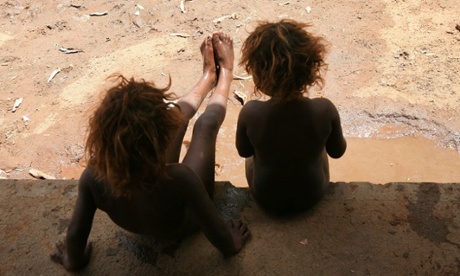Report card finds patchy progress at best on narrowing the gap with non-Indigenous Australians

The child mortality rate among Indigenous Australians has significantly improved, more than halving for infants under the age of one, but efforts to improve mental health and reduce instances of suicide and incarceration have gone backwards, a Productivity Commission report has revealed.
The Overcoming Indigenous Disadvantage (OID) report, released on Wednesday, examines the nationally set indicators of the health and wellbeing of Aboriginal and Torres Strait Islander people. It is the sixth report in a series, and the first in three years.
It found there was a significant decline in child mortality between 1998 and 2012 from 217 to 146 deaths per 100,000. The mortality rates for infants more than halved over the same time.
The life expectancy gap between Indigenous and non-Indigenous Australians narrowed from 11.4 years to 10.6 years for males and from 9.6 years to 9.5 years for females between 2005-07 and 2010-12.
While several outcomes had improved, those for incarceration and juvenile detention, suicide and self-harm, mental health and access to basic services such as clean water, functioning sewerage and electricity, have gone backwards.
Admissions to hospital for intentional self-harm increased by an alarming 48% between 2004-05 and 2012-13, and the proportion of adults reporting high or very high psychological distress rose from 27% to 30% over the same period. The suicide rate among Indigenous people between 2008 and 2012 was almost double that of the non-Indigenous population.
Calls have mounted for immediate and more effective action against a rising epidemic of suicide, particularly in remote areas and among younger and younger children.
Between 2000 and 2013 the adult Indigenous imprisonment rate increased by 57%, widening the gap as the non-Indigenous rate did not show significant change, and the rate of juvenile detention sits at about 24 times that of non-Indigenous youth.
“Imprisonment has a heavy social and economic impact,” the report said.
“High rates of imprisonment remove adults from their roles caring for the next generation, and can lead to the ‘normalisation’ of incarceration among community members.”
The Abbott government has been strongly criticised for its sweeping cuts to legal aid and other justice services since coming to power. Despite promises that no front line services would be affected, several organisations have cut staff or closed their doors.
The North Australian Aboriginal Justice Agency is closing its Nhulunbuy office due to funding cuts, despite an increasing caseload.
Many of the outcomes identified in the OID report are compounded by the difficulties of remote living. Indigenous Australians were 11 times more likely to be living in remote or very remote areas than non-Indigenous.
Problems such as overcrowding increased in proportion to remoteness, and rates of year 12 attainment decreased.
Five of the 12 Council of Australian Government (Coag) targets and headline indicators have shown positive progress. As well as life expectancy and child mortality, household and individual income, year 12 attainment and post-secondary education improved.
“The proportion of Aboriginal and Torres Strait Islander 20–24 year olds completing year 12 or equivalent or above increased from 45% in 2008 to 59% in 2012-13,” the report said.
“For non-Indigenous Australians, the proportion remained between 86% and 88%.”
There was no significant change in literacy and numeracy, disability and chronic disease, or family and community violence.
The OID report is the most comprehensive of its kind, and is designed to inform government policy.
The report also looked at specific programs and social or strategic factors which were having a positive impact, such as “effective governance and leadership and recognition of culture”.
“[These] play essential parts in the social and economic development of Aboriginal and Torres Strait Islander Australians,” it said.
It recommended governments examine data which suggested that addressing a single issue with a whole-of-government approach could have positive effect on a number of other problems.
“Sometimes a single, well-targeted action can influence a range of outcomes. These interactions emphasise the need for a whole-of-government approach to assessing the costs and benefits of such actions,” it said.
Housing was typically regarded as a state or territory responsibility, but reducing overcrowding could affect a number of the Coag targets, including literacy and numeracy levels, family and community violence, and disability, it said.
“Although other influences are also important in each of these areas, there is sufficient evidence for education, health and justice departments to be concerned about housing issues.”
The report called for greater value to be placed on Indigenous culture, and better engagement and participation from Indigenous people with services and decision-making.
The recommendation is in line with calls from elders and grassroots organisations for Indigenous suicide prevention to focus on a reconnection with culture and for strategies to include Indigenous people and groups.
